Lakhmir Singh & Manjit Kaur: Reflection of Light, Solutions- 2 | Science Class 10 PDF Download
Page No:175
Question 36: A man stands 10 m in front of a large plane mirror. How far must he walk before he is 5 m away from his image ?
Solution : Initially, the distance between the man and the mirror is 10m.
So, the distance between man and his image is 10+10 = 20m
Distance between the man and his image is 5 m when the man is 2.5 m away from the mirror.
Therefore, he has to walk 10 m – 2.5m = 7.5 m towards the mirror
Question 37: An object is placed 20 cm in front of a plane mirror. The mirror is moved 2 cm towards the object. The distance between the positions of the original and final images seen in the mirror is :
(a) 2 cm,
(b) 4 cm
(c) 10 cm
(d) 22 cm
Solution : Initially, the object is placed 20 cm in front of mirror. So the image will form 20 cm behind the mirror.
If mirror is moved 2 cm towards the object,
distance between object and mirror = 20 cm – 2 cm = 18 cm
distance between mirror and image = 18 cm, which is 2 cm less than the initial case.
Since, the mirror has also moved 2 cm away from the position of original image, so the total distance between the positions of the original and final images is 2 cm + 2 cm = 4 cm
Question 38: A man sits in an optician’s chair, looking into a plane mirror which is 2 m away from him and views the image of a chart which faces the mirror and is 50 cm behind his head. How far away from his eyes does the chart appear to be ?
Solution : Distance between the man and the mirror = 2 cm
Distance between man and chart = 50 cm = 0.5 m
Distance between chart and mirror = 0.5 m + 2 m = 2.5 m
Distance between mirror and the image of the chart = 2.5 m
Distance between man and the image of chart = Distance between man and the mirror + Distance between mirror and the image of the chart = 2 m + 2.5 m = 4.5 m
Question 39: A ray of light strikes a plane mirror PQ at an angle of incidence of 30°, is reflected from the plane mirror and then strikes a second plane mirror QR placed at right angles to the first mirror. The angle of reflection at the second mirror is :
(a) 30° (b) 45° (c) 60° (d) 90°
Draw a ray-diagram to illustrate your answer.
Solution :
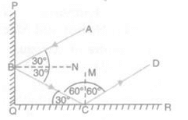
Ray AB strikes the mirror PQ at B and gets reflected along BC according to the laws of reflection. The ray BC incident on mirror QR makes an angle of 30o with the mirror. So, the angle of incidence on this mirror is 90o-30o = 60o. Hence, the angle of reflection is also 60o.
Question 40: Explain how to read the following message which was found on some blotting paper :

Solution : The impression on blotting paper is the mirror image of the written massage. Therefore, to read this message we need to hold the written message in front of a mirror so that the mirror produces a laterally inverted image of this message.
Page No:178
Question 1: Name the spherical mirror which has :
virtual principal focus.
real principal focus.
Solution : (a) Convex mirror (b) Concave mirror
Question 2: Out of convex mirror and concave mirror, whose focus is situated behind the mirror ?
Solution : Convex mirror
Question 3: Find the focal length of a concave mirror whose radius of curvature is 32 cm.
Solution : Radius of curvature (R) = 32cm
Focal length (f) = ?
We know that
f = R/2
= 32/2
f = 16cm
Question 4: If the focal length of a convex mirror is 25 cm, what is its radius of curvature ?
Solution : Focal length (f) = 25 cm
Radius of curvature (R) = ?
We know that
f = R/2
25=R/2
R= 25 x 2
R = 50 cm.
Page No:179
Question 5: Fill in the following blanks with suitable words :
Parallel rays of light are reflected by a concave mirror to a point called the………..
The focal length of a concave mirror is the distance from the………. to the mirror.
A concave mirror…….. rays of light whereas a convex mirror……… rays of light.
For a convex mirror, parallel rays of light appear to diverge from a point called the…………
Solution : (a) principal focus.
(b) principle focus.
(c) converges; diverges.
(d) principle focus.
Question 6: What is a spherical mirror ? Distinguish between a concave mirror and a convex mirror.
Solution : A spherical mirror is that mirror whose reflecting surface is the part of a hollow sphere of glass. The spherical mirrors are of two types: concave mirrors and convex mirrors.
Difference between concave mirror and convex mirror:
A concave mirror is that spherical mirror in which the reflection of light takes place at concave surface (or bent-in surface), whereas a convex mirror is that spherical miror in which the reflection of light takes place at the convex surface (or bulging out surface).
Concave mirror converges the parallel rays of light that fall on it, whereas convex mirror diverges the parallel rays of light that fall on it.
Question 7: Name the two types of spherical mirrors. What type of mirror is represented by the :
(a) back side of a shining steel spoon ?
(b) front side of a shining steel spoon ?
Solution : Two types of spherical mirrors are:
(i) Concave mirror
(ii) Convex mirror
Type of mirror represented by the:
(a) back side of a shining steel spoon – convex mirror
(b) front side of a shining steel spoon – concave mirror
Question 8: What is the relation between the focal length and radius of curvature of a spherical mirror (concave mirror or convex mirror) ? Calculate the focal length of a spherical mirror whose radius of curvature is 25 cm.
Solution : For a spherical mirror the principal focus (F) lies exactly mid-way between the pole (P) and centre of curvature (C). So, the focal length (f) of a spherical mirror is equal to half of its radius of curvature (R).
f = R/2
R = 25cm (Given)
f = ?
We know that
f = R/2
= 25/2
f = 12.5cm
Question 9: Explain with a suitable diagram, how a concave mirror converges a parallel beam of light rays. Mark clearly the pole, focus and centre of curvature of concave mirror in this diagram.
Solution :
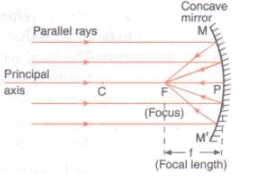
All the light rays which are parallel to the principal axis of a concave mirror, converge at the the principal focus (F) after reflection from the mirror. Since a concave mirror converges a parallel beam of light rays, it is also called a converging mirror.
Question 10: Describe with a suitable diagram, how a convex mirror diverges a parallel beam of light rays. Mark clearly the pole, focus and centre of curvature of convex mirror in this diagram.
Solution :
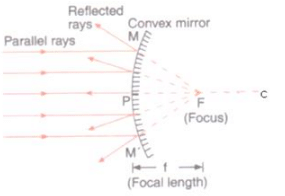
All the light rays which are parallel to the principal axis of a convex mirror, appear to diverge from the principal focus (F) after reflection from the mirror. Since a convex mirror diverges a parallel beam of light rays, it is also called a diverging mirror.
Question 11: Define (a) centre of curvature (b) radius of curvature (c) pole (d) principal axis, and (e) aperture, of a spherical mirror with the help of a labelled diagram.
Solution :
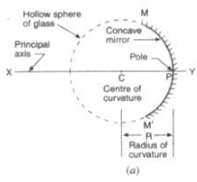
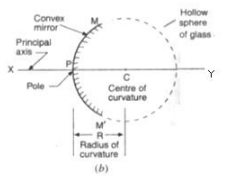
(a) Centre of curvature: Centre of curvature of a spherical mirror is the centre of the hollow sphere of glass of which the mirror is a part.
(b) Radius of curvature: Radius of curvature of a spherical mirror is the radius of the hollow sphere of glass of which the mirror is a part.
(c) Pole: The centre of a spherical mirror is called its pole.
(d) Principal axis: The straight line passing through the centre of curvature and pole of a spherical mirror is called its principal axis.
(e) Aperture: The portion of a mirror from which the reflection of light actually takes place is called the aperture of the mirror.
Question 12: (a) Define (i) principal focus of a concave mirror, and (ii) focal length of a concave mirror.
Draw diagram to represent the action of a concave mirror on a beam of parallel light rays. Mark on this diagram principal axis, focus F, centre of curvature C, pole P and focal length ƒ, of the concave mirror.
Solution : (a) (i) Principal focus of a concave mirror: The principal focus of a concave mirror is a point on its principal axis to which all the light rays which are parallel and close to the axis, converge after reflection from the concave mirror.
(ii) Focal length of a concave mirror: The focal length of a concave mirror is the distance between its pole and the principal focus.
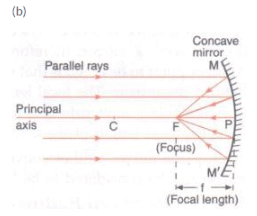
Question 13: (a) What is meant by (i) principal focus of a convex mirror, and (ii) focal length of a convex mirror ?
(b) Draw diagram to show the action of convex mirror on a beam of parallel light rays. Mark on this diagram principal axis, focus F, centre of curvature C, pole P and focal length ƒ, of the convex mirror.
Solution : (a) (i) Principal focus of a convex mirror: The principal focus of a convex mirror is a point on its principal axis from which a beam of light rays, initially parallel to the axis, appears to diverge after being reflected from the convex mirror.
(ii) Focal length of a concave mirror: The focal length of a convex mirror is the distance from the pole (P) to its principal focus (F).

Question 19: A communications satellite in orbit sends a parallel beam of signals down to earth. If these signals obey the same laws of reflection as light and are to be focussed onto a small receiving aerial, what should be the best shape of the metal ‘dish’ used to collect them ?
Solution : Concave metal dish: It will collect the parallel beam of satellite signals at its focus where receiving aerial is fixed.
Question 20: When a spherical mirror is held towards the sun and its sharp image is formed on a piece of carbon paper for some time, a hole is burnt in the carbon paper.
(a) What is the nature of spherical mirror ?
(b) Why is a hole burnt in the carbon paper ?
(c) At which point of the spherical mirror the carbon paper is placed ?
(d) What name is given to the distance between spherical mirror and carbon paper ?
(e) What is the advantage of using a carbon paper rather than a white paper ?
Solution : (a) Concave mirror
(b) A lot of sun’s heat rays are concentrated at the point of sun’s image which burn the hole in carbon paper.
(c) At the focus.
(d) Focal length.
(e) A black carbon paper absorbs more heat rays and hence burns a hole more easily (than a white paper).
Page No:189
Question 1: For what position of an object, a concave mirror forms a real image equal in size to the object ?
Solution : At the centre of curvature.
Question 2: Where should an object be placed in front of the concave mirror so as to obtain its virtual, erect and magnified image ?
Solution : Between pole and focus.
Question 3: For which positions of the object does a concave mirror produce an inverted, magnified and real image ?
Solution : Between focus and centre of curvature.
Question 4: If an object is placed at the focus of a concave mirror, where is the image formed ?
Solution : At infinity.
Question 5: If an object is at infinity (very large distance) in front of a concave mirror, where is the image formed ?
Solution : At focus.
Question 6: For what position of an object, a real and diminished image is formed by a concave mirror ?
Solution : Beyond the centre of curvature.
Question 7: Copy this figure in your answer book and show the direction of the light ray after reflection :

Solution :
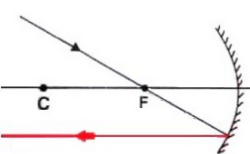
Direction of light fay after reflection
Question 8: Draw the following diagram in your answer book and show the formation of image of the object AB with the help of suitable

Solution :
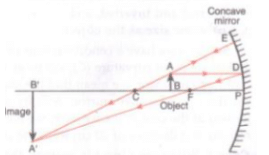
Question 9: Draw the following diagram in your answer book and show the formation of image with the help of suitable rays

Solution :
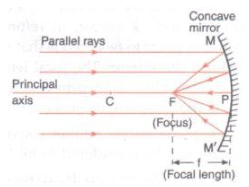
Fig. formation of image of AC
Question 10: Which type of mirror could be used as a dentist’s mirror ?
Solution : Concave mirror.
Question 11: Which kind of mirror is used in the headlights of a car ? Why is it used for this purpose ?
Solution : Concave mirror is used in the headlights of a car. This is because when a lighted bulb is placed at the focus of a concave mirror reflector, then the diverging light rays of the bulb are collected by the concave reflector and then reflected to produce a strong, parallel-sided beam of light (which travels a considerable distance in the darkness of night).
Question 12: Explain why, a ray of light passing through the centre of curvature of a concave mirror gets reflected back along the same path.
Solution : A ray of light passing through the centre of curvature of a concave mirror is reflected back along the same path because it strikes the concave mirror at right angles to its surface due to which the angle of incidence and angle of reflection both are oo.
Question 13: What is the minimum number of rays required for locating the image formed by a concave mirror for an object ? Draw a ray diagram to show the formation of a virtual image by a concave mirror.
Solution : Minimum two rays are required for locating the image formed by a concave mirror for an object.
Ray diagram for the formation of a virtual image by a concave mirror:
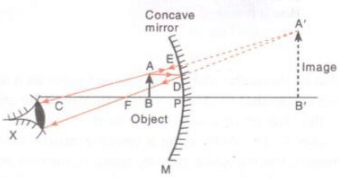
Question 14: With the help of a ray diagram, determine the position, nature and size of the image formed of an object
placed at the centre of curvature of a concave mirror.
Solution : When an object is placed at the centre of curvature (C) of a concave mirror, the image formed is:
(i) at the centre of curvature (C),
(ii) real and inverted,
(iii) of same size as the object.
Question 15: Describe with the help of a diagram, the nature, size and position of the image formed when an object is placed beyond the centre of curvature of a concave mirror.
Solution : When an object is placed beyond the centre of curvature (C) of a concave mirror, the image is:
(i) between the focus and centre of curvature,
(ii) real and inverted,
(iii) smaller than the object (or diminished).
Question 16: If an object is placed at a distance of 8 cm from a concave mirror of focal length 10 cm, discuss the nature of the image formed by drawing the ray diagram.
Solution : The focal length of the mirror is PF = 10 cm.
The object is placed at B such that PB = 8 cm. This means that the object lies between the pole and focus of the concave mirror.
The image formed is virtual, erect and magnified.
Question 17: Draw a ray diagram showing how a concave mirror can be used to produce a real, inverted and diminished image of an object.
Solution :
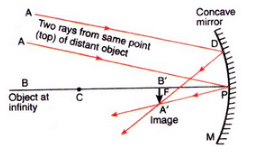
Page No:190
Question 18: Which mirror is used as a torch reflector ? Draw a labelled diagram to show how a torch reflector can be used to produce a parallel beam of light. Where is the bulb placed in relation to the torch reflector ?
Solution : Concave mirror is used for a torch reflector.
Diagram:
Bulb is placed at the focus of the torch reflector.
Question 19: State where an object must be placed so that the image formed by a concave mirror is :
(a) erect and virtual.
(b) at infinity.
(c) the same size as the object.
Solution : (a) Between pole and focus of the mirror.
(b) At the focus of the mirror.
(c) At the centre of curvature of the mirror.
Question 20: With the help of a labelled ray diagram, describe how a converging mirror can be used to give an enlarged upright image of an object.
Solution :
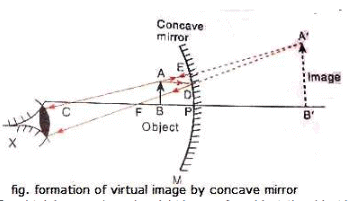
For obtaining an enlarged upright image of an object, the object is placed between focus (F) and pole (P) of the concave mirror.
A ray AD parallel to the principal axis, gets reflected at D and then passes through the focus F. A second ray AE passing through the centre of curvatue C strikes the mirror normally at point E and gets reflected back along the same path.
Now, two reflected rays DF and EC are diverging rays and, therefore, do not intersect each other on the left side. The reflected rays DF and EC are produced backwards (as shown by dotted lines). On producing backwards, they appear to intersect at point A’ behind the concave mirror. Thus, A’ is the virtual image of point A of the object. To get the complete image of the object we draw A’B’ perpendicular to the axis. Thus, A’B’ is the image of the object AB formed by the concave mirror. The image is bigger in size than the object, hence it is an enlarged image.
Question 21: Make labelled ray diagrams to illustrate the formation of :
(a) a real image by a converging mirror.
(b) a virtual image by a converging mirror.
Mark clearly the pole, focus, centre of curvature and position of object in each case.
Solution : (a) A real image by a converging mirror
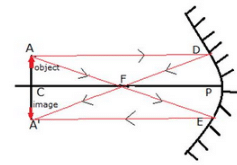
(b) A virtual image by a converging mirror
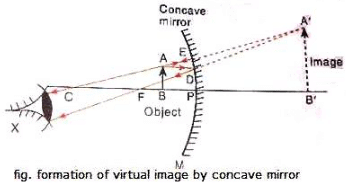
Question 22: Briefly describe how you would find the focal length of a concave mirror quickly but approximately.
Solution : When the object is at a considerable distance (or at infinity) from a concave mirror, then its image is formed at the focus. This fact can be used to find out the focal length of a concave mirror quickly but approximately.
We focus a distant object (several metres away) like a window or tree on a screen by using a concave mirror whose focal length is to be determined. The sharp image of window or tree will be formed at the focus of the concave mirror. That is, the distance of image (or screen) from the concave mirror will be equal to the focal length of concave mirror. This distance can be measured with a scale. It will give us the approximate focal length of the concave mirror.
Question 23: Which type of mirror is used in a solar furnace ? Support your answer with reason.
Solution : Concave mirror is used in a solar furnace.
The solar furnace is placed at the focus of a large concave reflector. When parallel rays of light from the sun fall on the surface of the concave mirror, rays gets reflected and meet at the focus of the mirror due to the converging nature of concave mirror. Thus, the furnace kept at the focus becomes very hot. Even steel can be melted in this furnace.
Question 24: Name the type of mirror used by dentists. How does it help ?
Solution : Concave mirror is used by dentists.
The dentist holds a small concave mirror in such a way that the tooth lies within its focus. A magnified image of the tooth is then seen by the dentist in the concave mirror. Since the tooth looks much bigger, it becomes easy to examine the defect in the tooth.
Question 25: Explain why, concave mirrors are used as shaving mirrors.
Solution : Concave mirrors are used as shaving mirrors. This is because when the face is placed close to a concave mirror (so that the face is within its focus) the concave mirror produces a magnified and erect image of the face. Since a large image of the face is seen in the concave mirror, it becomes easier to make a smooth shave.
Question 26: Give two uses of concave mirrors. Explain why you would choose concave mirrors for these uses.
Solution : Uses of concave mirror
(i) Concave mirrors are used as shaving mirrors. This is because when the face is placed close to a concave mirror (so that the face is within its focus) the concave mirror produces a magnified and erect image of the face. Since a large image of the face is seen in the concave mirror, it becomes easier to make a smooth shave.
(ii) Concave mirrors are used by dentists to see the large images of the teeth of patients. This is because when a tooth is within the focus of a concave mirror, then an enlarged image of the tooth is seen in the mirror. Due to this, it becomes easier to locate the defect in the tooth.
Question 27: (a) Draw ray-diagrams to show the formation of images when the object is placed in front of a concave
mirror (converging mirror) :
(i) between its pole and focus
(ii) between its centre of curvature and focus Describe the nature, size and position of the image formed in each case.
(b) State one use of concave mirror based on the formation of image as in case (z) above.
Solution :

fig. formation of Image by the concave mirror when the object
Is pelted between Its pole and focus.
When object is placed between the pole and focus of a concave mirror, the image is formed behind the mirror, it is virtual, erect and larger than the object.

When object is placed between the centre of curvature and focus of a concave mirror. the image is formed beyond the centre of curvature. it is real. inverted and larger than the object.
(b) One use of concave mirror based on the formation of image as in case (i) above: As a shaving mirror.
Question 28: (a) Give two circumstances in which a concave mirror can form a magnified image of an object placed in
front of it. Illustrate your answer by drawing labelled ray diagrams for both.
(b) Which one of these circumstances enables a concave mirror to be used as a shaving mirror ?
Solution : (a) (i) When the object is placed between the pole and focus of a concave mirror, a magnified image is formed.
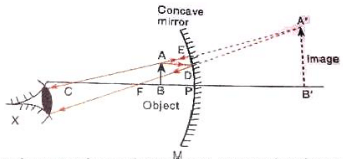
fig. formation of image by the concave mirror when the object is palced between its pole and focus.
(ii) When the object is placed between the focus and the centre of curvature of a concave mirror, a magnified image is formed.
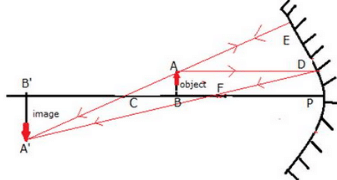
(b) A concave mirror can be used as a shaving mirror when the object is placed between the pole and focus of a concave mirror.
|
85 videos|437 docs|75 tests
|
FAQs on Lakhmir Singh & Manjit Kaur: Reflection of Light, Solutions- 2 - Science Class 10
| 1. What is the law of reflection of light? |  |
| 2. How does reflection of light occur? |  |
| 3. What is the difference between regular reflection and diffuse reflection? |  |
| 4. How does the angle of incidence affect the angle of reflection? |  |
| 5. What are the applications of reflection of light in everyday life? |  |

|
Explore Courses for Class 10 exam
|

|


















